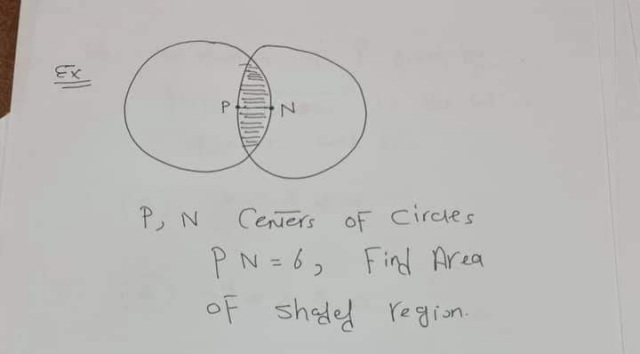Can someone explain this question plz ?
2020-09-17 12:14 am

回答 (6)
2020-09-17 1:14 am
Refer to the figure below.
The two circles meet at A and B. Join PA, PB, NA and NB.
PN is the common radius of the two circles.
Hence, radii PA = PB = PN = NA = NB = 6
ΔPAN and ΔPBN are equilateral triangles with each side = 6 and each angle = 60°
Area of ΔPAN
= Area of ΔPBN
= (1/2) × 6 × 6 × sin60°
= 18 × (√3/2)
= 9√3
Area of segment AP
= Area of segment BN
= Area of segment BP
= Area of segment AN
= (Area of sector PAN) - (Area of ΔPAN)
= 6π - 9√3
Area of the shaded region
= (Area of ΔPAN) × 2 + (Area of segment AP) × 4
= (9√3) × 2 + (6π - 9√3) × 4
= 18√3 + 24π - 36√3
= 24π - 18√3
≈ 44.3313
The two circles meet at A and B. Join PA, PB, NA and NB.
PN is the common radius of the two circles.
Hence, radii PA = PB = PN = NA = NB = 6
ΔPAN and ΔPBN are equilateral triangles with each side = 6 and each angle = 60°
Area of ΔPAN
= Area of ΔPBN
= (1/2) × 6 × 6 × sin60°
= 18 × (√3/2)
= 9√3
Area of segment AP
= Area of segment BN
= Area of segment BP
= Area of segment AN
= (Area of sector PAN) - (Area of ΔPAN)
= 6π - 9√3
Area of the shaded region
= (Area of ΔPAN) × 2 + (Area of segment AP) × 4
= (9√3) × 2 + (6π - 9√3) × 4
= 18√3 + 24π - 36√3
= 24π - 18√3
≈ 44.3313

2020-09-17 2:05 am
Bad calculator work
Area = 24pi -18*sqrt(3) (this is correct)
but it does not equal 44.3313
It does equal this
Area = 44.22130915
So both answers which complete the problem
using different methods
really have the same solution if it weren't for a typo. or poor
calculator work
Area = 24pi -18*sqrt(3) (this is correct)
but it does not equal 44.3313
It does equal this
Area = 44.22130915
So both answers which complete the problem
using different methods
really have the same solution if it weren't for a typo. or poor
calculator work
2020-09-17 1:50 am
One set of circle which meets this picture
(x-6)^2 + (y-6)^2 = 36
x^2 + (y-6)^2 = 36
center are P (0,6), N (6,6)
Then, distance between center would be
distance = sqrt ( 6^2 + 0^2 ) = sqrt(36) = 6
Intersection
x^2 + (y-6)^2 = (x-6)^2 + (y-6)^2
x^2 = x^2 -12x +36
-12x + 36 = 0
12x =36
x = (36/12) = 3
(3-6)^2 + (y-6)^2 = 36
9 + (y-6)^2 =36
(y-6)^2 =27
taking the square root of both sides
(y-6) = +/- 3*sqrt(3)
y-6 = +/- 3*sqrt(3)
y = 6 +/- 3*sqrt(3)
The area of the shaded is
the area of two chord topped
circular segments.
this is formula for the area of one of the segments
A=(R^2/2) ( theta - sin(theta) )
R = 6
R^2 = 36
A (of one circular segment) = 18(theta-sin(theta) )
so (1/2)theta = arccos( opp/hyp) =
(1/2)theta = arcos(3/ ( sqrt( ( (3-0)^2 + (6- (6 - 3*sqrt(3))^2)
(1/2)theta = arcos( 3/ sqrt( 9 + (3*sqrt(3)^2 )
(1/2)theta = arcos(3/ sqrt( 9 + 9*3 )
(1/2) theta = arcos( 3/sqrt(36) = arcos(1/2) =pi/3 + 2pi
or -pi/3 + 2pi
but the (1/2)theta is less than pi/2
(1/2)theta = pi/3
theta = 2pi/3
A(one circular segment) = 18( 2pi/3 - sin(2pi/3) )
A(one circular segment) = 18(2pi/3 - sqrt(3)/2 )
so but we have two circular segments
All Area = 36(2pi/3 - sqrt(3)/2) = 44.22130915 square units
Article on determining the area of a circular segment
https://en.wikipedia.org/wiki/Circular_segment#:~:text=In%20geometry%2C%20a%20circular%20segment,a%20secant%20or%20a%20chord.
(x-6)^2 + (y-6)^2 = 36
x^2 + (y-6)^2 = 36
center are P (0,6), N (6,6)
Then, distance between center would be
distance = sqrt ( 6^2 + 0^2 ) = sqrt(36) = 6
Intersection
x^2 + (y-6)^2 = (x-6)^2 + (y-6)^2
x^2 = x^2 -12x +36
-12x + 36 = 0
12x =36
x = (36/12) = 3
(3-6)^2 + (y-6)^2 = 36
9 + (y-6)^2 =36
(y-6)^2 =27
taking the square root of both sides
(y-6) = +/- 3*sqrt(3)
y-6 = +/- 3*sqrt(3)
y = 6 +/- 3*sqrt(3)
The area of the shaded is
the area of two chord topped
circular segments.
this is formula for the area of one of the segments
A=(R^2/2) ( theta - sin(theta) )
R = 6
R^2 = 36
A (of one circular segment) = 18(theta-sin(theta) )
so (1/2)theta = arccos( opp/hyp) =
(1/2)theta = arcos(3/ ( sqrt( ( (3-0)^2 + (6- (6 - 3*sqrt(3))^2)
(1/2)theta = arcos( 3/ sqrt( 9 + (3*sqrt(3)^2 )
(1/2)theta = arcos(3/ sqrt( 9 + 9*3 )
(1/2) theta = arcos( 3/sqrt(36) = arcos(1/2) =pi/3 + 2pi
or -pi/3 + 2pi
but the (1/2)theta is less than pi/2
(1/2)theta = pi/3
theta = 2pi/3
A(one circular segment) = 18( 2pi/3 - sin(2pi/3) )
A(one circular segment) = 18(2pi/3 - sqrt(3)/2 )
so but we have two circular segments
All Area = 36(2pi/3 - sqrt(3)/2) = 44.22130915 square units
Article on determining the area of a circular segment
https://en.wikipedia.org/wiki/Circular_segment#:~:text=In%20geometry%2C%20a%20circular%20segment,a%20secant%20or%20a%20chord.

2020-09-17 12:18 am
Circle P and Circle N intersect such that line PN = 6.
The area of the shaded region:
The area of the shaded region:
2020-09-18 6:53 am
Set up a rectangular coordinates system through P as center, with the x-axis
coincident with PN & the y-axis through P. The circle P has equation as
x^2+y^2=36
=>
the area of the shaded part
.......6..............6
A=2S(2y)dx=4Ssqr(36-x^2)dx
.......3..............3
Let x=6sinB, then dx=6cosBdB
=>
.........pi/2
A=144Scos^2(B)dB
.........pi/6
=>
........pi/2
A=72S[cos(2B)+1]dB
........pi/6
=>
A=72[pi/3-sqr(3)/4]=24pi-18sqr(3)~44.2213.
coincident with PN & the y-axis through P. The circle P has equation as
x^2+y^2=36
=>
the area of the shaded part
.......6..............6
A=2S(2y)dx=4Ssqr(36-x^2)dx
.......3..............3
Let x=6sinB, then dx=6cosBdB
=>
.........pi/2
A=144Scos^2(B)dB
.........pi/6
=>
........pi/2
A=72S[cos(2B)+1]dB
........pi/6
=>
A=72[pi/3-sqr(3)/4]=24pi-18sqr(3)~44.2213.
2020-09-17 12:46 am
P is a point --- the center of the left circle. = = = you put the point too far to the right.
N is a point --- the center of the circle on the right === Again -- this point is too for to the left.
line PN is 6 unit long ==== it is more than yu have drawn it.
The shaded part has a point at the top and bottom. To solve the problem you need to put those points on the drawing and label them something ... Maybe the top point is A and the bottom point is B. Whatever you want. This allows you to draw some extra lines .. PA, PB, NA, NB, and AB. === This makes some triangles, actually, the larger triangles are isosceles. Now us what you know and -- do the problem. Looks like a Geometry problem == HS geometry was more than 50 years ago... Good luck.
N is a point --- the center of the circle on the right === Again -- this point is too for to the left.
line PN is 6 unit long ==== it is more than yu have drawn it.
The shaded part has a point at the top and bottom. To solve the problem you need to put those points on the drawing and label them something ... Maybe the top point is A and the bottom point is B. Whatever you want. This allows you to draw some extra lines .. PA, PB, NA, NB, and AB. === This makes some triangles, actually, the larger triangles are isosceles. Now us what you know and -- do the problem. Looks like a Geometry problem == HS geometry was more than 50 years ago... Good luck.
收錄日期: 2021-04-30 17:19:48
原文連結 [永久失效]:
https://hk.answers.yahoo.com/question/index?qid=20200916161453AAp0veb


